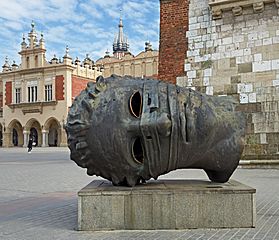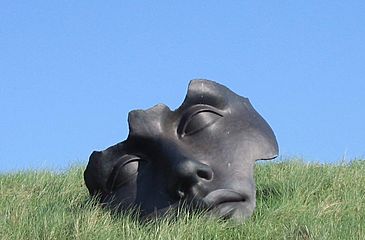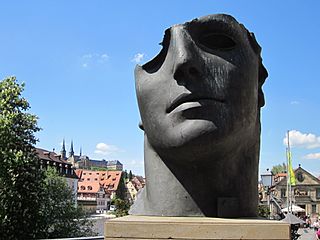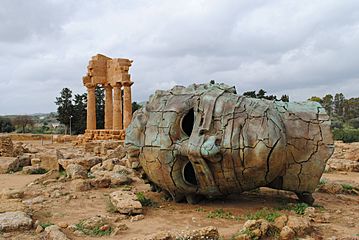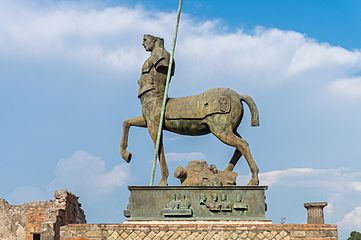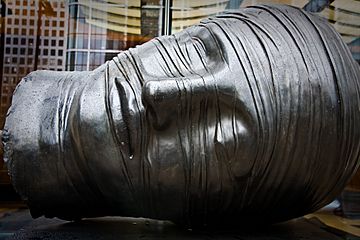Igor Mitoraj facts for kids
Quick facts for kids
Igor Mitoraj
|
|
|---|---|
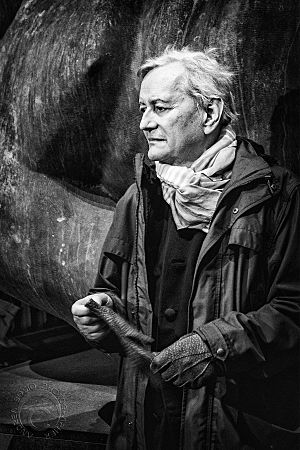
Mitoraj in 2014
|
|
| Born | 26 March 1944 Oederan, Germany
|
| Died | 6 October 2014 (aged 70) |
| Nationality | Polish |
| Education | Kraków Academy of Art |
| Known for | Sculptor |
|
Notable work
|
Luci di Nara Eros Bendato Héros de Lumière |
Igor Mitoraj (born March 26, 1944 – died October 6, 2014) was a famous Polish artist and sculptor. He was known for his unique sculptures of the human body, which often looked like they were broken or in pieces. Many of his large artworks were placed in public spaces for everyone to see. He is considered one of the most well-known Polish sculptors around the world.
Contents
About Igor Mitoraj
Igor Mitoraj was born in Oederan, Germany, on March 26, 1944. His mother was Polish and had been forced to work there during World War II. His father was a French officer with Polish family. After the war ended, Igor and his mother returned to Poland. He grew up in Grojec.
Igor went to art school in Bielsko-Biała. In 1963, he began studying painting at the Kraków Academy of Art. His teacher was a famous artist named Tadeusz Kantor. After he finished his studies, Igor showed his art in several group exhibitions. His first solo exhibition, where only his art was shown, was in 1967 at the Krzysztofory Gallery in Poland.
In 1968, Igor moved to Paris, France, to continue his art studies. Soon after, he became very interested in art and culture from Latin America. He spent a year traveling and painting in Mexico. This trip inspired him to start making sculptures.
He returned to Paris in 1974. Two years later, he had another big solo exhibition at the Gallery La Hune. This show included some of his new sculptures. The success of this exhibition convinced him that he was meant to be a sculptor.
Igor first worked with materials like terracotta (a type of clay) and bronze (a metal). In 1979, he visited Carrara, Italy, which is famous for its marble. This trip made him decide to use marble as his main material. In 1983, he opened his own art studio in Pietrasanta, Italy.
In 2006, he created new bronze doors and a statue of John the Baptist for a church called Santa Maria degli Angeli e dei Martiri in Rome. In 2003, he moved back to Poland.
Igor Mitoraj received important awards for his art. In 2005, he was given the Golden Medal of Medal for Merit to Culture - Gloria Artis. In 2012, he received the Commander's Cross of the Order of Polonia Restituta.
Art Style
Igor Mitoraj's sculptures were inspired by ancient Greek and Roman art. This style often focused on the human body, especially the torso (the main part of the body).
However, Mitoraj added his own special touch. He often made sculptures of bodies that looked broken or had missing parts, like arms or legs. This was a "post-modern" idea, which means it was a new way of looking at older art. His sculptures often looked like ancient statues that had been damaged over time.
Through his art, Mitoraj explored ideas about the human body. He showed its beauty, but also how fragile it can be. His works often made people think about suffering and the deeper parts of human nature, and how things change or wear down over time.
Gallery
-
Héros de Lumière, Carrara marble (1986) at the Yorkshire Sculpture Park
-
Centurione I, 1987, Bamberg, Germany.
-
Centauro, Forum of Pompeii, Pompeii, Italy.
-
Testa Addormentata, bronze, 1983, located at Bank Street, Outside West Wintergarden, Canary Wharf, London, Great Britain
-
Centurione I, bronze, 1987, located at Columbus Courtyard, Canary Wharf, London, Great Britain
-
Centauro, bronze, 1984, located at Montgomery Square, Canary Wharf, London, Great Britain
See also
 In Spanish: Igor Mitoraj para niños
In Spanish: Igor Mitoraj para niños


